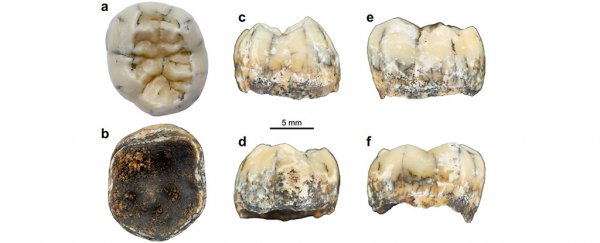Deep in the forests of Laos, in a cave in the Annamite Mountains, lay a single child's tooth. That tooth – an unassuming molar - could be from a mysterious species of human we know little about, and of which few remains are known to exist.
"Analyses of the internal structure of the molar in tandem with palaeoproteomic analyses of the enamel indicate that the tooth derives from a young, likely female, Homo individual," researchers write in a new study.
The tooth, from the Tam Ngu Hao 2 cave, "most likely represents a Denisovan", the researchers say.
Denisovans are an extinct species of human first discovered when an analysis of a child's finger bone found in a Siberian cave in 2008 was determined to not be a fit for any known human species.
From what we can tell from specimens dated almost all the way back to 200,000 years ago, Denisovans share close genetic similarities with Neanderthals.
However, finding specimens has been incredibly slim pickings. Six fossilized teeth and bones have been discovered in the same Siberian cave, while one partial mandible has been found in a cave in China.
So, the discovery of a potential Denisovan tooth from Laos – far south of the caves of Siberia or China – is extremely exciting for researchers.
"The tooth from Tam Ngu Hao 2 Cave in Laos thus provides direct evidence of a most likely Denisovan female individual with associated fauna in mainland Southeast Asia by 164-131 thousand years ago," the team writes in their new paper.
"This discovery further attests that this region was a hotspot of diversity for the genus Homo, with the presence of at least five late Middle to Late Pleistocene species: H. erectus, Denisovans/Neanderthals, H. floresiensis, H. luzonensis and H. sapiens."
Because the molar only recently completed development (at the time of the individual's death), and showed no signs of being worn, the team believes that the tooth is from a child between 3.5 to 8.5 years old when they died. Using sediment from around the tooth, they dated the tooth to between 164 to 131 thousand years old.
Unfortunately, when it comes to ancient single teeth, it's not easy to confirm that it's definitely Denisovans. The team wasn't able to sample for ancient DNA due to the age of the specimen, in part because of the tropical conditions that likely destroyed any trace of DNA many thousands of years ago.
But by analyzing proteins in the tooth alongside its morphology, the team are pretty sure it's Denisovan, although it could also be from a Neanderthal. We'll need more analysis to confirm one way or the other.
"The differences from Neanderthals that we observe do not preclude [the tooth] TNH2-1 from belonging to this taxon and would make it the south-eastern-most Neanderthal fossil ever discovered," the team writes.
"However, considering the morphological particularities of TNH2-1 in unison, as well as the high-degree of morphodimensional similarities with the molars of the Denisovan specimen from [the Chinese cave] Xiahe, the most parsimonious hypothesis is that TNH2-1 belongs to this sister group of Neanderthals."
The research has been published in Nature Communications.
